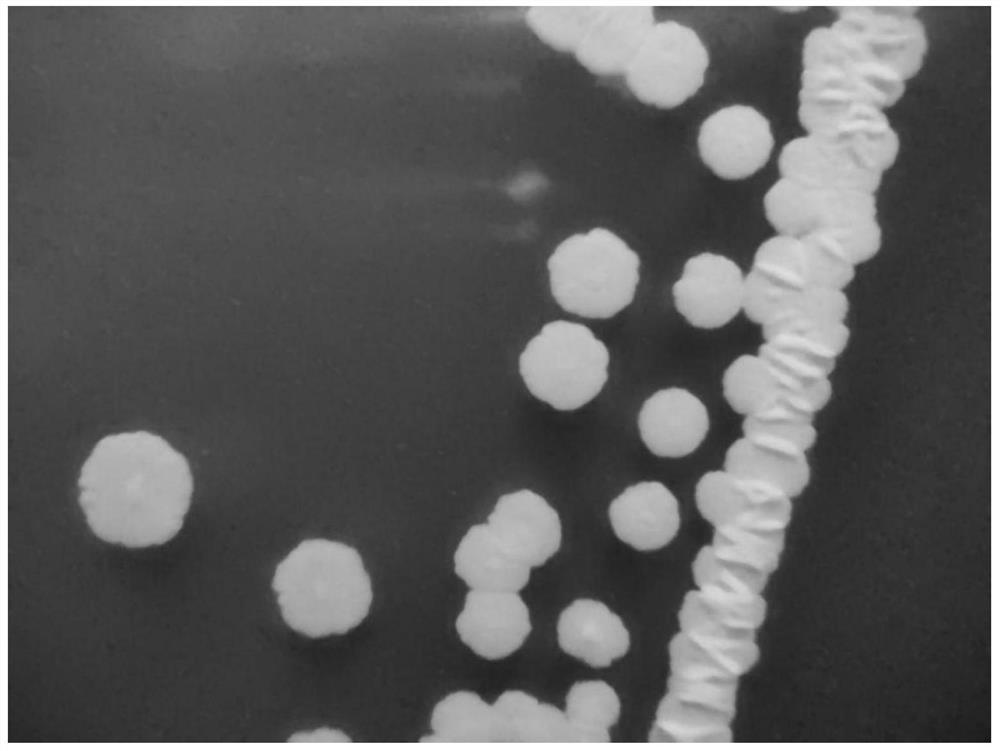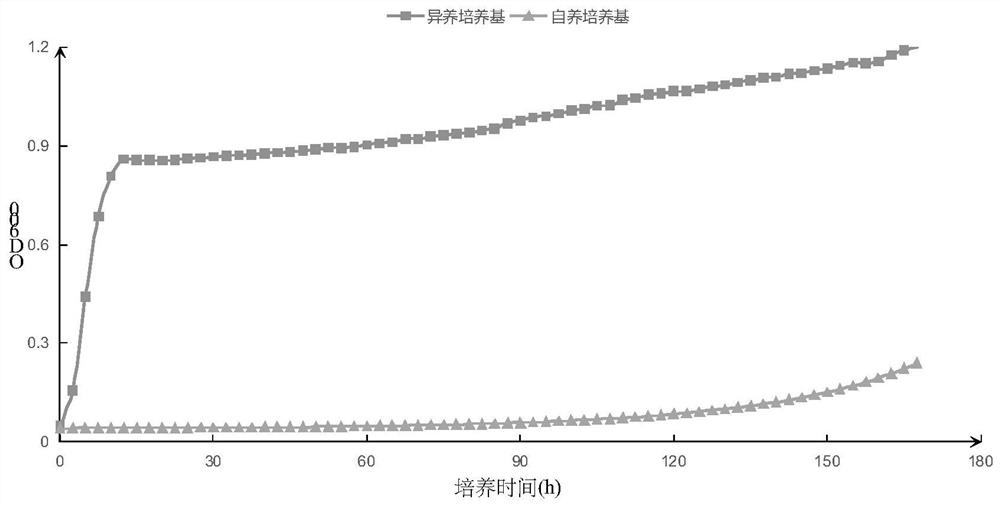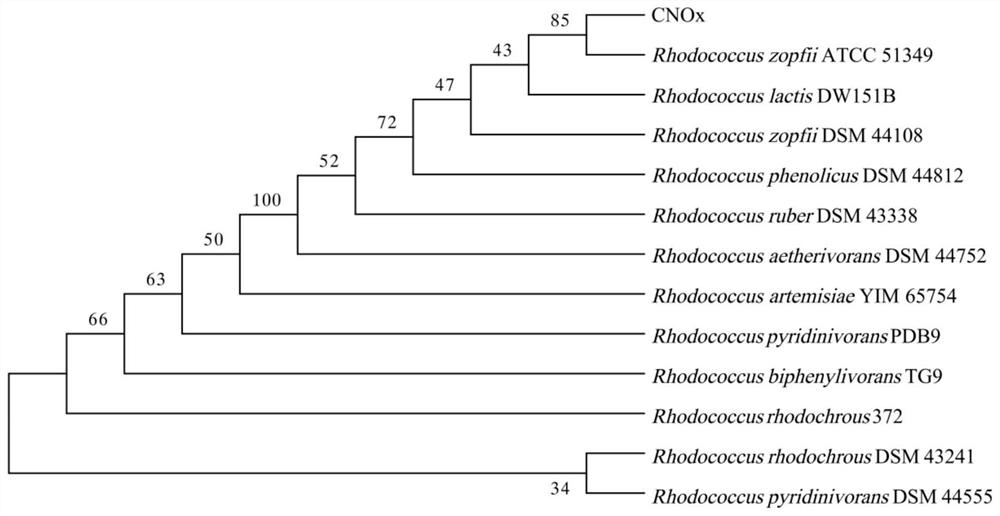A Facultative Nutritional Ammonia Oxidizing Bacteria and Its Application
A rhodococcus and denitrification technology, applied in the field of environmental microorganisms, to achieve the effects of increasing processing costs, avoiding carbon source input, and enhancing environmental tolerance
- Summary
- Abstract
- Description
- Claims
- Application Information
AI Technical Summary
Problems solved by technology
Method used
Image
Examples
Embodiment 1
[0033] Example 1: Screening and Identification of Bacterial Strains
[0034] 1. Prepare the medium as follows:
[0035] (1) Nitrification (autotrophic) medium: KHCO 3 1g / L, KH 2 PO 4 0.5g / L, CaCl 2 2H 2 O0.3g / L, MgSO 4 ·7H 2O 1g / L, (NH 4 ) 2 SO 4 2g / L, CaCO 3 2g / L. In addition, 2 mL of trace elements I and 2 mL of trace elements II were added per liter. The final pH of the medium was between 7.0 and 7.5. Increase agarose 12g / L, namely solid nitrifying (autotrophic) medium.
[0036] Trace element solution Ⅰ: EDTA 20.71g / L and FeSO 4 ·7H 2 O 9.15g / L.
[0037] Trace element solution Ⅱ: ZnSO 4 ·7H 2 O 430mg / L, MnCl 2 4H 2 O 990mg / L, H 3 BO 3 14mg / L, CoCl 2 ·6H 2 O 240mg / L, CuSO 4 ·5H 2 O 250mg / L, NiCl 2 ·6H 2 O190mg / L, (NH 4 ) 6 Mo 7 o 24 4H 2 O550mg / L.
[0038] (2) Nitrification (heterotrophic) medium: (NH 4 ) 2 SO 4 2.0g / L, glucose 9.09g / L, sodium acetate 6.20g / L, sodium succinate 6.13g / L, sodium citrate 7.42g / L, sucrose 4.32g / L, Vickers...
Embodiment 2
[0075] Example 2: Synergistic treatment of high-concentration wastewater COD and ammonia nitrogen by nitrifying bacteria CNOx
[0076] With the fermented broth of 6L nitrifying bacteria CNOx (viable bacteria concentration ≥ 10 9 CFU / mL) were collected by low-temperature centrifugation, and then divided into two parts with equal mass in the ultra-clean workbench, one of which was sterilized at 115°C for 30 minutes as a control treatment, and the other was temporarily stored at 4°C. After the sterilization is finished, inoculate two parts of bacteria into 8L plexiglass tanks filled with 6L of high-concentration organic wastewater (COD is 15200mg / L, ammonia nitrogen content is 1640mg / L), stir well and then aerate (3L / min) treatment, using sodium carbonate to replenish alkalinity every day, maintaining the pH of the solution between 7.5 and 8.0, and replenishing water according to the initial liquid level, and taking samples to measure COD, ammonia nitrogen, nitrite nitrogen, nit...
Embodiment 3
[0080] Example 3: Application of nitrifying bacteria CNOx in short-range nitrification and denitrification denitrification reactor
[0081] Short-range nitrification and denitrification denitrification technology refers to controlling the nitrification reaction to NH 4 + →NO 2 - stage, to avoid or reduce the occurrence of NO 2 - →NO 3 - conversion, directly to NO 2 - →N 2 Reaction. Compared with the traditional nitrification and denitrification technology, short-cut nitrification and denitrification has the following advantages: the aerobic stage can save 25% of the oxygen consumption; the anoxic stage can reduce the carbon source consumption by 40%. At the same time, due to NO 2 - →N 2 The reaction rate is NO 3 - →N 2 1.5 to 2 times of that, so the denitrification residence time can be greatly shortened. In addition, short-cut nitrification and denitrification can effectively reduce sludge production. Through the screening test of the strains in Example 1, i...
PUM
 Login to View More
Login to View More Abstract
Description
Claims
Application Information
 Login to View More
Login to View More - R&D
- Intellectual Property
- Life Sciences
- Materials
- Tech Scout
- Unparalleled Data Quality
- Higher Quality Content
- 60% Fewer Hallucinations
Browse by: Latest US Patents, China's latest patents, Technical Efficacy Thesaurus, Application Domain, Technology Topic, Popular Technical Reports.
© 2025 PatSnap. All rights reserved.Legal|Privacy policy|Modern Slavery Act Transparency Statement|Sitemap|About US| Contact US: help@patsnap.com



